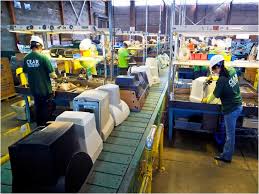
E-waste disposal methods refer to the systematic handling and managing of electronic waste streams created by or resulting from discarded or obsolete electronic devices and equipment. Essentially, this would include anything that runs on electricity or contains electronic components. Electronic waste, or e-waste, is considered the fastest-growing waste stream worldwide. Estimates of over 50 million tons of e-waste are generated each year. Companies and organizations must establish proper e-waste disposal methods to prevent dangerous or hazardous materials from damaging the environment or ecosystem.
What Is Considered E-Waste?
The category of e-waste encompasses a wide range of products, from small consumer electronics like smartphones, tablets, chargers, and laptops to larger appliances like refrigerators, microwaves, flat-panel TVs, and washing machines. However, e-waste streams can be extensive for companies and organizations, including desktop computers, CPUs, computer monitors, servers, motherboards, keyboards, cables, and accessories. Electrical and electronic components like circuit boards, batteries, surge protectors, and wiring for office equipment like printers, photocopiers, scanners, lighting fixtures, and even fax machines.
Properly Managing E-Waste
With over 50 million tons of e-waste generated annually, the need for its proper disposal has never been greater. It’s also the law. Many electronic devices contain harmful elements such as lead, cadmium, beryllium oxide, chromium, or mercury and harmful compounds such as chlorofluorocarbons, brominated flame retardants, or polychlorinated biphenyls (PCBs). Dangers arise from accumulation of elements and chemicals in soil, water, and food, but also from inhalation of toxic fumes. When improperly disposed of, these toxins can leach into the environment and pose risks to human health and ecosystems, putting people, land, and sea animals at risk.
Responsible management of hazardous materials to mitigate the environmental and health risks associated with e-waste should be a priority for companies and organizations. Industries ranging from healthcare and research, microelectronics, banking and finance to the telecommunications sectors, contract manufacturers, educational institutions, and government offices routinely generate e-waste that must be properly disposed of.
How to Dispose of E-Waste
Efforts to address e-waste disposal vary. The best e-waste disposal methods prioritize environmental sustainability, recycling programs, legislation to regulate its disposal, and partnering with e-waste service providers to manage waste streams. Effective e-waste disposal methods include:
Reuse, Refurbish, Resell, or Donate
This is by far the most environmentally friendly way to dispose of e-waste. Before disposing of older or dated equipment, explore opportunities to reuse or refurbish electronic devices. If your computer is still functional, consider upgrading it rather than disposing of it. Otherwise, it can be donated or sold to organizations and charities that accept used electronics for refurbishment and distribution to underserved communities.
Recycling
Proper recycling of e-waste is one of the leading methods of disposal. It involves breaking down electronic devices into their component parts and recycling or reusing them. Components like metals, plastics, glass, and circuit boards can be extracted and reused to manufacture new electronics. If your company is generating large quantities of e-waste, it must be disposed of properly by law. Consult with your local or state Department of Environmental Protection or ask your hazardous waste management service provider about e-waste recycling programs. E-waste recycling centers employ environmentally responsible methods to extract valuable materials while safely disposing of hazardous substances.
Take-Back and Trade-In Programs
Many electronics manufacturers, companies, and retailers offer take-back programs, which accept old devices and equipment for recycling when you purchase a new one. Some companies may offer a discount when trading older devices for newer ones. These programs help ensure responsible disposal and the proper recycling of e-waste.
Legislation and Regulation Compliance
Be aware of and comply with local, national, and international e-waste disposal regulations and guidelines. Maine has specific laws governing electronic waste disposal to protect the environment and human health.
Contact the Professional E-Waste Service Providers at MLI Environmental
As e-waste contains hazardous materials, companies, and organizations have a cradle-to-grave responsibility to dispose of those materials properly. Companies and organizations that generate e-waste must comply with e-waste disposal regulations. E-waste service providers not only help companies manage their e-waste stream but can help ensure compliance.
MLI Environmental assists its customers with managing their electronic waste to provide a more sustainable practice for their business. We offer services like e-scrap, which collects unwanted or outdated electronics that can be recycled. We can dispose of universal waste like batteries, ballasts, and fluorescent lamps. If your facility has security measures to dispose of sensitive material securely, we can securely dispose of electronic equipment that holds important data for your company.
At MLI Environmental, we know that proper e-waste disposal methods can help promote the sustainable use of electronic resources. By promoting responsible e-waste management, we protect both the environment and human health and reduce the negative impacts of electronic waste on our communities. For more information on our e-waste disposal programs, contact MLI Environmental today.
